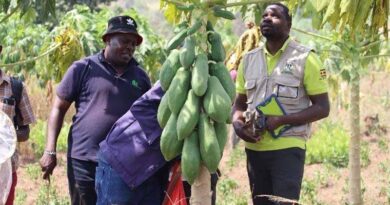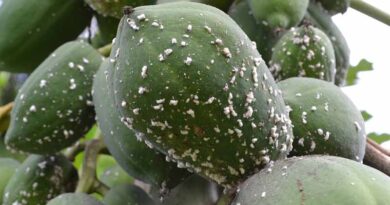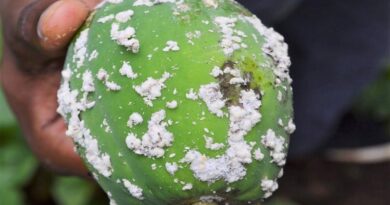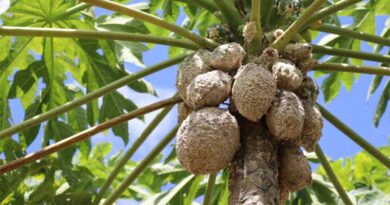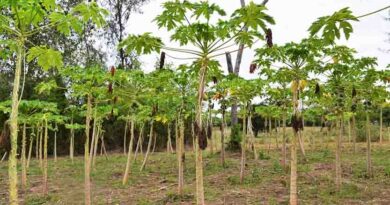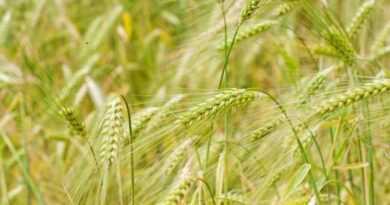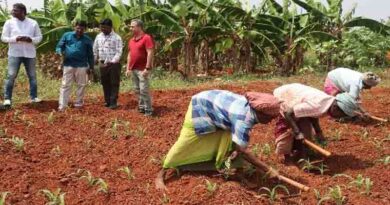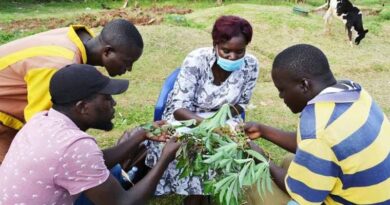Common Papaya Disorders: A Comprehensive Guide
03 April 2024, Kenya: Papaya, also commonly known as the papaw or pawpaw, is a large tropical fruit-producing plant originating from Central America. Market demand for tropical fruits has steadily grown, and consequently, the papaya has become an important agricultural export in many countries around the world. As of 2020, India was the largest producer of papaya, followed by the Dominican Republic and Brazil.
However, the papaya faces several key problems with pests and diseases. Chiefly the papaya ringspot virus (PRSV) and post-harvest losses due to fungal diseases, physiological disorders and mechanical damage. This blog post will highlight the range of papaya disorders which impact papaya (Carica papaya) production. Being able to identify these common disorders is crucial for effective management.
Papaya Pests: Insects, Nematodes and Mites
Species from these three groups pose significant threats to papaya plants, causing damage to leaves, fruit, and overall plant health. Read on to find out more about the range of papaya pests.
Insects
Here are some of the most common insect offenders:
The Oriental fruit fly complex consists of three extremely similar-looking fruit fly pest species that require expert knowledge to differentiate between them. These include the Oriental fruit fly (Bactrocera dorsalis), papaya fruit fly (Toxotrypana curvicauda) and carambola fruit fly (Bactrocera carambolae), which are all smaller than a housefly and are brown and yellow in appearance. Fruit flies are major crop pests, causing problems for over 200 types of fruit and vegetables.
These flies then lay their eggs beneath the skin, into the middle of the papaya fruit. When the larvae hatch, they feed on the developing seeds and fruit within the papaya. Consequently, the mature larva later tunnels out of the fruit and pupates in the soil. Meanwhile, the infested fruit rots and falls early. In addition, the puncture holes, created when the flies lay their eggs, often allow further diseases to attack the fruit.
Moths (and caterpillars) are a group that varies in size and colour and feeds on various parts of the plant. Usually, it’s the larvae that cause damage, affecting leaves and fruits. However, it’s the adult form of the fruit-piercing moth (Eudocima fullonia) which is a pest of papaya. It feeds at night by piercing the skin of ripe fruit with its mouthparts, causing internal injuries (bruising and dryness beneath the skin) and secondary rots.
Mealybugs
Two key papaya insect pests are in the mealybug family Pseudococcidae: the citrus mealybug (Planococcus citri) and the papaya mealybug (Paracoccus marginatus). Mealybugs are small, oval-shaped, soft-bodied insects that suck sap from leaves, stems, and roots. They are typically covered with a white, waxy, or fluffy coating, which makes it difficult to see their actual bodies making them difficult to identify. The adult citrus mealybug has a pinkish-white colour, whereas the papaya mealybug adult has a yellowish-white colour. Additionally, the small white ‘fingers’ around the mealybug are more obvious on the citrus mealybug than those on the papaya mealybug.
Heavy infestations lead to distorted growth, premature leaf drop and fruit fall, and the formation of yellow spots on leaves. When infested, the fruit loses value or cannot be sold at markets at all. Large numbers may also result in an accumulation of excreted honeydew. The honeydew is often then colonised by sooty moulds, giving plant surfaces a blackened appearance.
Please find additional resources for papaya mealybug management advice here: Global, Pakistan, Cambodia, Kenya, Malawi, India, Bangladesh.
Scales
Next up are scales, small oval insects found on the leaves, fruit, and branches of plants. Interestingly they show considerable sexual dimorphism (differences between the males and females of the species). The adult females are larger (up to 2mm in diameter) and immobile, whereas the adult males are mobile and look like very small (~1mm) grains of rice. Like mealybugs, scale can produce honeydew which can lead to the growth of sooty moulds, which reduces plant vigour and may lead to plant death.
Both the white peach scale (Pseudaulacaspis pentagona) and snow scale (Unaspis citri) are notable papaya pest species. The white peach scale females are circular with a conical shape, and the tip of the cone is slightly darkened. This species is usually found on leaves and fruits and causes leaf chlorosis and twig dieback. Whereas, the snow scale gets its name from the white waxy armour that forms on the yellow nymphs. This species can reach extremely high numbers on fruit and leaves.
Mites
Mites differ from insects as they are actually part of the spider class (Arachnida), so they have a combined head and thorax section, unlike insects which have these separate to create three sections. They are minute creatures found mostly on the undersides of leaves, feeding on plant fluids.
Both the broad mite (Polyphagotarsonemus latus) and false spider mite (Brevipalpus phoenicis) are papaya pests. However, due to their small size, a hand lens is needed to identify them. Symptoms of the broad mite include curled edges of young leaves, rigid and stiff foliage with a brown or scorched appearance, and small leaves which don’t expand fully. On the other hand, the false spider mite is reddish in colour and moves very quickly across the surface of fruit or leaves. It can create marks, scarring and sometimes a mosaic on leaves and fruit, reduce plant vigour and, finally, affect the taste of the fruit.
Additional Resources: Red spider mite and broad mite on papaya-Global (CABI), Red spider mite on papaya-Kenya (CABI).
Nematodes
Nematodes are extremely small parasitic worms that cannot be seen by the naked human eye. They can damage papaya roots, leading to wilting and reduced plant vigour. Root-knot nematodes (Meloidogyne spp.) cause galls (or lumps) to form on roots, causing stunted growth and chlorosis. Severe infections can lead to plant death.
Papaya Diseases: Fungi and Water moulds
Fungi
Fungi are a diverse group of organisms; most do not attack plants, but fungal plant pathogens can be some of the most serious causes of lost yield in any cropping environment. They can attack all plants and all parts of those plants. Some live in the soil and attack roots, whereas others attack the above-ground parts of the plant. The key fungal diseases which affect papaya are:
Powdery mildew (Oidium caricae-papayae)
The disease begins as lower leaf surfaces become spotted with small water-soaked yellow spots. Later these become powdery patches of fungus and spores. These patches are usually near the veins and are more clearly seen in humid conditions.
Yellow patches later become necrotic (brown) and scorched; leaves may curl and fall from trees early.
As spots enlarge, the disease becomes easily recognisable with patches of white powdery material that join and eventually cover the entire fruit. As the fruit ripens, the fungus may disappear leaving behind grey scars.
Additional Resources: Powdery mildew on papaya-Kenya (CABI)
Black spot
(Asperisporium caricae)
Lesions start as water-soaked spots that become brown (necrotic). These then develop into pale circular leaf spots up to 4mm in diameter, often surrounded by a yellow ring (chlorotic halo).
Young leaves are not attacked, but severely damaged older leaves fall off, and up to half of the leaves can fall off, causing a reduced vigour.
This disease is most severe in wet weather, as wind and rain aid its dispersal.
Additional resources: Black spot of papaya-Kenya (CABI)
(Cercospora sp.)
This fungi causes tiny black dots on the fruit, which tend to enlarge to approximately 3mm across; additionally, spots are slightly raised and indistinct on unripe green fruit.
Becomes visible on ripening; lesions on leaves are irregular in shape and grey-white in colour; if the infection is severe, leaves may turn yellow, die and drop from the plant.
Corynespora brown spot/Target spot (Corynespora cassiicola)
Pale yellow lesions with brown centres grow on the upper leaf surface, 1-2mm in diameter, but can join into larger areas.
On the lower leaf surface small, light, and water-soaked brown spots with a yellow halo form, turning necrotic.
All lesions become brown and sunken with reddish margins; spores are more apparent on lower surfaces.
Lower leaves are particularly susceptible. Heavy infections may result in premature defoliation with losses in yield and sometimes fruit quality.
Additional Resources: Corynespora leaf spot (EWS Plant Doctor)
Grey mould (Botrytis cinerea)
An opportunistic pathogen that will attack weak and over-ripe fruit. It will particularly occur in times of high humidity and especially on damaged fruit.
A characteristic grey fluffy fuzz of spores will cover the rot, which gradually spreads over the fruit.
Colletotrichum rot/Anthracnose (Glomerella cingulata, formerly Coletotrichum gloeosporiodes)
Small water-soaked spots appear on the fruit surface as ripening commences.
As the spots develop, they become sunken and can enlarge up to 50mm in diameter. The spots turn brown-black and may produce pinkish-orange fungal masses in the centre.
This fungi is often present on over-ripe fruits.
The internal tissue is firm with a greyish-white discolouration.
Additional Resources: Papaya: Ripe fruit rots (Queensland Gov.), Anthracnose: Papaya (TNAU AgriTech Portal)
Black rot/Papaya leaf spot (Mycosphaerella caricae)
Identifiable by small, dark, sunken, water-soaked regions and wrinkled fruits.
It mainly attacks young fruits, usually at the point of contact with dead leaves. It can affect ripening fruits through broken fruit stalks. May cause premature fruit drop and fruits may ooze sap.
Water moulds
Water moulds, or oomycetes, are not true fungi but are caused by fungus-like organisms. This group includes some of the most devastating plant diseases, including some key problems for papaya production. Phytophthora blight (Phytophthora palmivora, Phytophthora nicotianae) is one of the most devastating diseases of papaya. This disease can cause a wide range of damage, including damping-off, root rot and fruit rot.
Fruit rot initially appears as small, circular, water-soaked spots about 5-10mm in diameter, often forming first where the fruit touches the stem of the plant. A milky sap may be exuded from the spots.
As the pathogen spreads within the fruit, it becomes covered with whitish fungal growth and masses of Phytophthora sporangia.
Stem cankers, which develop most frequently at the top of the stem where the fruit is borne, induce fruit and leaf fall.
Root rot: the first sign tends to be browning and wilting of the trees. Roots become dark and rotten, causing stunting of plant growth, and leaves appear yellow and may collapse.
Damping-off: the rapid wilting and death of very young plants. Shoots and roots become necrotic; seedlings become necrotic with watery roots; seeds have watery rots.
Additional Resources: Papaya Phytophthora fruit & root rot (Pestnet)
Papaya Diseases: Viruses and Bacteria
Bacteria are very different from fungi or water moulds (although they can sometimes produce similar symptoms in plants). Individually they can never be seen with the naked eye, but in huge numbers, they can be visible as gooey slimes. Viruses are much smaller than bacteria; they never produce structures that can be seen (even with a powerful light microscope).
Here are the key viral and bacterial diseases which affect papaya production:
Papaya Ringspot Virus (PRSV)
Papaya ringspot, caused by PRSV, is largely the most important disorder for papaya producers. Initial symptoms include yellowing and vein clearing (the loss of the normal green colouration of leaf veins, usually yellowing). Following on, yellow leaf mottling, leaf distortion, reduced leaf size, and ring spots on fruit (which can be distinctive c-shaped markings) may occur. PRSV severely affects plants reducing growth, fruit quantity and quality, and if severe, the plant may not produce fruit at all. Please find additional resources here for Ghana, Kenya.
Papaya Bunchy Top Virus (Rickettsia sp.)
Initial symptoms include diffuse chlorosis in young leaves and a reduction in normal leaf expansion. Small (0.5mm) water-soaked spots appear on leaf stalks and plant stems, which can grow to 1-2mm in diameter with time. General yellowing and thickening of leaves give a ‘bunchy top’ appearance. In addition, the fruit may become bitter, and the entire tree may die in severe cases.
Papaya Dieback (Erwinia papayae)
This bacterial disease attacks the top of the leaf stalks, leading to yellowing, then browning, and eventually, the leaf collapses. Lesions are likely to ooze, and maggots may be seen feeding off this. If the tip of the plant is infected, the whole plant will rot and die. Symptoms of papaya dieback can be confused with Phytophthora infections. To rule this out, split them stem down the centre; the infection should be seen growing from the top, whereas Phytophthora infections begin at the base.
Papaya Disorders: Nutrient Deficiencies
Plants require certain essential nutrients to grow and produce healthy fruits or vegetables. Without these, plants will show various symptoms, particularly leaf yellowing and distinctive patterns. Finally, let’s look at crop nutrient deficiencies which affect the papaya.
Boron Deficiency
Boron cannot be relocated around the plant, so the tip of the plant is the first region to show symptoms. The leaves are likely to appear brittle and puckered or distorted. The affected fruit are seedless, ripen unevenly and can be covered in lumps. Affected plants can lose up to 100% of their fruit. Further information can be found here: Prevention of boron deficiency in pawpaw-Malawi (CABI).
Iron Deficiency
The characteristic symptom of iron deficiency is yellow leaves at the top of the plant in which the leaf veins have remained green. Additionally, the fruit may have a reduced sugar content.
To conclude, understanding these common papaya disorders is essential for effective management strategies. Regular monitoring, proper sanitation, and targeted treatments can help protect papaya plants from these threats. Early detection and prompt action are key to preserving the health of your papaya orchard.
Also Read: Drumstick Cultivation, an Example From Gujarat, Turning a Poor Farmer Into a Millionaire
(For Latest Agriculture News & Updates, follow Krishak Jagat on Google News)


